Rhinoplasty
For improved
aesthetics and breathing
Rhinoplasty should be done for
own self and not to fit in someone else's box.
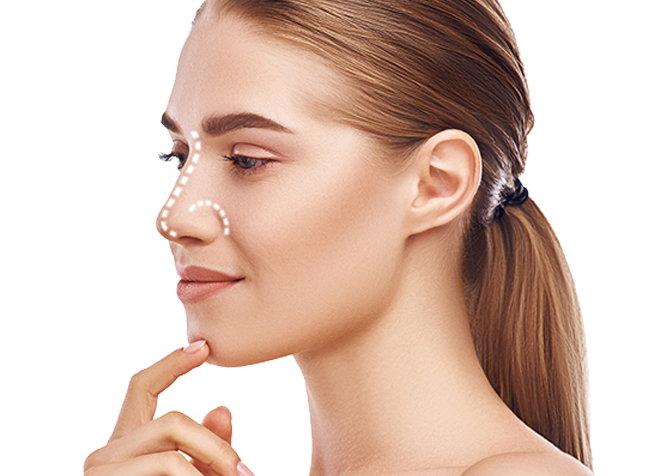
Rhinoplasty should be done for own self and not to fit in someone else's box.
What we see attracts the most. Outward appearance elicits opinions from family, Friends and strangers as well because we live in a visual culture. In this outward appearance, nose plays a very important role in beautification of a person. Beauty encompasses both proportion and the harmonious balance of individual facial features and how they work together. Thus the concept of beautiful nose is very simple. A nose that is relatively small, straight and symmetrical. 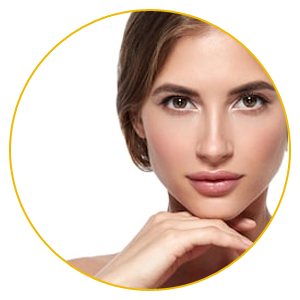
Rhinoplasty often referred as nose job in simple terms is a surgical procedure which enhances the proportion of the nose and also the facial harmony. It's a procedure used for the reconstructing and correcting the nose and can be done to change how you look or for medical reasons. For example, some people may need surgery to repair a problem with the cartilage (septum) that divides one nostril from the other. Many others may just want to make their nose smaller or change its shape. It can also correct the impaired breathing caused by the structural defects in the nose. A good result in contemporary aesthetic Rhinoplasty is a redefined, natural appearing nose.
It is a common procedure used for-
- Removing a hump on the nose
- Straightening the bridge
- Reshaping the nose's tip
- Increasing or decreasing the size of the nostrils
- Correcting the nose after an injury
- Opening breathing passages
- Making the nose bigger or smaller
Rhinoplasty can treat a variety of major defects such as:
Crooked Nose: a nose that does not follow a straight, vertical line down the centre of your face is called as crooked nose. The treatment of crooked nose depends on the degree of crookedness. There are two main types of crooked noses. One type is caused by an issue within the complex system of bones, cartilage and tissue that make up your nose. This can be a result of several things, including: 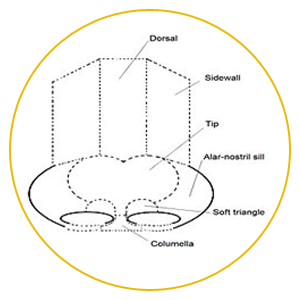
- Birth or congenital defects
- Surgery on your nose
- Trauma or injuries such as broken nose
- Severe infections
- Tumours
Saddle nose : It is characterized by a loss of height of the nose, because of the collapse of the bridge most commonly due to trauma. But can be due to several other conditions like infections, leprosy and syphilis.
Under developed nose and Binder's syndrome : Binder syndrome is acongenital disease affecting the face. The condition results in undergrowth of the central face and may include elements of the nose and upper jaw.
Teenagers should not have a nose job until the nose has reached its adult size or can say till the nose achieves skeletal maturity. This usually happens about age 13 or 14 (preferably 15) for girls, and a year or so later for boys.
Rhinoplasty can treat
- Thesize of the nose in relation to facial balance.
- Nose profile with depressions on the bridge and visible humps.
- Position of the nostrils and width of the nose at the bridges.
- Nostrilsthose are upturned, wide and large.
- Nasalasymmetry
- Nasal tip that is upturned or hooked, enlarged or bulbous or drooping.
Discussions during a Rhinoplasy consultation should include
- Your condition in reference to your surgery with regard to both appearance and breathing.
- Previous medical treatments, medical conditions and drug allergies
- Current medications and supplements
- Tobacco, alcohol and drug use
- Any previous surgeries
A candidate opting for Rhinoplasty should fill up these criteria for better results
- You should be physically healthy
- Your facial growth should be complete
- You should preferably be a non-smoker.
- You should be confident and positive about your looks to achieve the improvement of your appearance.
- You should be motivated enough to undergo the procedure.
- You should have realistic expectations.
Dr Amit Agarwal's focus during consultation would be
- Examine and measure different proportions of your face and nose
- Discuss the options for your nose surgery
- Bone and cartilage donor sites and discuss about them
- Take photographs
- Any pre-existing health conditions and evaluation of your general health.
- Risk and complications related to outcome of surgery.
Questions to be asked with your surgeon about your surgery
- Are you a good candidate for the procedure?
- How and where will heper form the surgery?
- What are the risks and complications related to the surgery?
- How long do I have to stay in the hospital?
- What is the procedure?
- Will there be scarring post-surgery?
- How long is the recovery period?
- When can I return to work and daily routines?
Preparations to be done for the surgery
- Consumption of Herbal supplements and anti inflammatory drugs should be avoided as they can increase bleeding.
- Avoid smoking
- Get the tests done which are prescribed by your surgeon.
- Admission will be done on the same day at the center.
- Written consent form will be signed explaining the procedure after the admission.
- Meeting with the anaesthetist for Pre-Anaesthetic check-up before the surgery.
- Nil per oral for minimum of 5-6 hours before the planned procedure.
Rhinoplasty procedure includes
- First step is to induce you in general anaesthesia. The procedure is always done in general anaesthesia except for very mild corrections which can treated under local anaesthesia. Best choice will be recommended after discussion with you by Dr Amit Agarwal.
- Second step is to infuse mild anaesthestic solution inside nose to control bleeding during surgery. Then a incision is made either using closed procedure where the incision is hidden inside the nose or using an open procedure where the incision is made across the columella (narrow strip of tissue that separates the nostrils). This incision allows access to reshape the nose.
- In the third step, the deviated septum is correctedif required. Septum can be straightened and projection inside the nose is reduced to improve breathing. Cartilage graft is taken from the septum to be used to correct/augmentnose at other parts.
- Fourth step includes reshaping the different structures of the nose which differs in every patient according to their requirements.
- For reshaping of the nose, sometimes implants are required which can be either taken from the body or can use synthetic materials. A piece of cartilage or bone can be taken from the body to fine the desired results. Cartilage is taken from the rib (chest wall), back of the ear. Bone can be taken from the elbow region/iliac crest. Tissues taken the body are the best and give adequate and long lasting results with minimal complications when compared to synthetic materials. Rib cartilage is only needed when major augmentation is required otherwise cartilage from nose and back of ear is sufficient in majority of cases. Dr Amit Agarwal strongly discourages use of synthetic material in nose as complication rates can be as high as 20 %. The incisions are so small, easily hidden and are relatively less painful. So we should not worry about the scars.The scar heals with time and cannot be noticed in six to twelve months.
- Sixth step is to close the incision after shaping the nose as desired. After closure, results are assessed and a packing is placed inside the nose if required and bandage or splint is placed outside for protection and support.
Recovery after the surgery
You will be made to walk 6 hours post-surgery or the very following day, depending on your will and wish.You will be discharged next day of the surgery. The completeresult of nose job will be seen after the swelling and bruising subsides. You should give your body 6-12 months' time for evaluation of best results.
In early recovery days, there will be swelling and mild bruising in and around the eyes which subsides in few weeks. There can be pain which usually decreases with the pain killers given by Dr Amit Agarwal
All should be aware that scars inside the nose and loss of mucosal sensation can give the feeling of a "blocked nose"
Nasal packing is removed after 48 hours. The protective splint or plaster will be removed in seven days after the surgery. The protector tapes are removed after 14 days.
Very few sutures will be mostly along the skin of the columella on the lower side which will be removed after 6 days and sutures inside the nostril will be dissolvable and do not require to be taken off.
- Little discomfort insideand over nose might last for few weeks.
- You can start exercising after three to four weeks post-surgery.
- You can return to work depending on your will power and the type of work required between 7 days to 14 days.
- You can return to your normal life style after two weeks of surgery
- It takes three weeks' time for a person to become Socially Presentable.
It takes 6 months to 1 year for the nasal contour to fully refine. Gradually after this the changes in your nose will be more prominent.
Precautionary instructions will be given by your surgeon which includes
- Keep head end elevation.
- To take care of the surgical site.
- How to take the medication and application of ointment and creams.
- Apply nasal drops every 2nd and 4th hourly.
The results of Rhinoplasty are more of permanent outcomes. After the initial swelling subsides, you can see gradual changes in your look for almost a year which after turns into beautiful permanent changes.
Unfavourable results/complications in Rhinoplasty
Rhinoplasty is always regarded to be associated with many risks as the expectations of patient and operating surgeon do not match primarily because of the limited predictability of the aesthetic result due to the dynamics of the healing process. Many different types of tissues are involved within the closed space of nose.The individual reactions of these tissues like bone and its covering layer periosteum, cartilage and its covering layer perichondrium, mucosa, skin and fat are not always under the control of the surgeon.
An unfavourable result of rhinoplasty is clearly visible as everybody is an expert. The patient very often blames the operating surgeon for the unfavourable result while the surgeon tends to call it a complication. In principle, both are possible.
Few problems however are in fact a mistake in surgical planning. Choosing and opting for a surgeon who has good experience in rhinoplasty will help in mitigating this problembecause an earnest analysis is essential for prevention. Sometimes very minor subtle flaw or correctionpeople demand to be rectified ontheir nose may not look good when done. Dr Amit Agarwal believes that the nose should look harmonious on the face and should be in balance with your facial profile.
Other complications are effects of the individual reaction and the healing process. They are not under the control of the surgeon. In this case the surgeon has to identify the complication early enough and react adequately.
The complications and aftermaths of the surgery vary from person to person and their physical well-being. The factors which affect are poor circulation, a history of blood clots, diabetes or heart, lung or liver infection. Nose job usually gives desired results but there can be some risks involved which include:
- Risks related to General anaesthesia which are very rare. Anaesthesia is very safe in present times and with best machines and a qualified anaesthetist, chances of encountering any complication is less than 0.1 percent in a healthy individual. We at Kayakriti Plastic Surgery and Dental Centre are equipped with world class anaesthesia workstation, other equipments and two very qualified intensivists for the surgical procedures to be very safe and smooth.
- 10% of the patients after rhinoplasty complain about residual or new breathing problems. Rhinoplasty can reduce the cross-sectional area of the nasal airways due to deep bone cutting, alar resections or valve problems.All should be aware that scars inside the nose and loss of mucosal sensation can give the feeling of a "blocked nose". Of all the patients who undergo revision-rhinoplasty, breathing disturbances are reported in 70%.
- The main risks of cartilage or bone implants are dislocation and resorption, while artificial materials can cause infection and extrusion. Silicone implants are reported to have a complication rate between 5-20%.
- Skin and soft tissues can have persistent swelling, collection of blood, infect, fibrosis, can have numbness, develop small cysts originating from displaced mucosa. In rare cases skin can develop necrosis or atrophy.
- Persistent post-ostoperative swelling is more often due to the osteotomy (bone cutting).Percutaneous osteotomies cause less traumabut may result in visible scars. Osteotomies can also cause injuries of the or bital region.
- Infections are rare but can happen in less than 1% of cases. Postoperative deformities are considered as main risks of rhinoplasty, causing revision surgery in 5% to 15% of the cases.
- Rare event of Deep Vein Thrombosis, pulmonary or cardiac complications, lidocaine toxicity can occur or precipitate in patients with multiple pre-existing diseases diagnosed or undiagnosed by routinely available standard tests or if multiple procedures are done in the same sitting. Kindly do not force your surgeon for combining multiple surgeries in one sitting which is never recommended by Dr Amit Agarwal and might turn a very safe procedure to an unsafe one. For example, combining sinus surgery with rhinoplasty is usually not recommended as it can increase the chances of infection around the face
These are the risks and possible complications which should be discussed by you with Dr Amit Agarwal before the procedure.
Independent of the indication, success of rhinoplasty should be based on patient's satisfaction. Assessment of the result by patient and surgeon can sometimes be different. Patients with mainly functional problems will rate a rhinoplasty successful when the breathing function is improved. The more aesthetic demands are involved in the surgery, the more patient's satisfaction will be based on multiple factors. A perfect result immediately after surgery may be totally different one year later and a not so perfect result may look better after a year. This can result in overall decreased satisfaction rate with the surgery. The dynamic healing process of bone, skin and soft tissues is unpredictable and out of control of the surgeon. Sometimes, patient's expectations can be unrealistic and beyond the capacity of the surgeon and can be a major reason for multiple revision rhinoplasties.
Frequently Asked Questions
Rhinoplasty can be done to enhance your looks or to get through any breathing difficulties. After a consultation with your surgeon, who will suggest you the best treatment after asking you about your concerns with your nose.
No. It won't be painful procedure as it's done under general anaesthesia mostly and appropriate pain killers are prescribed by Dr Amit Agarwal.
You will be admitted for one day at the centre. After the procedure and plaster you will be discharged after explaining you the medication and procedure related to removal of splint or plaster.
According to the changes required in your nose, the surgical procedure varies. If an open Rhinoplasty technique is used the skin is lifted through a small cut on the columella to perform the desired changes. The scar heals with time and cannot be noticed in six to twelve months.
In the initial days after the surgery, slight blockage can be experienced because of the packs, but nasal drops will be prescribed by Dr Amit Agarwal, which gradually subsides once the pack is removed. There could be temporary change of smell also which gets better with time.
There is a prominent swelling after the surgery. Once the splint or plaster is removed after a week, the changes are visible. As the swelling subsides gradually with time, the desired changes are prominent and apparent.
During the surgery, all the standard precautions are taken to avoid any kind of risk or complications but there are some risks with every surgery which are also relevant for Rhinoplasty. All measures to avoid risk and complications (if any) will be discussed by Dr Amit Agarwal during the consultation.
Rhinoplasty Images
Indivisual results may vary from person to person.
These pictures are shown for the purpose of education only.


Know your surgeon better
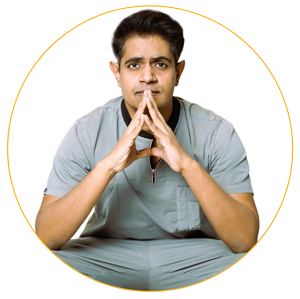
Best plastic surgeon, Dr. Amit Agarwal is an American Board Certified, extensively trained, and best Plastic & Aesthetic surgeon in Lucknow. He is the Chief Plastic Surgeon heading the Department of Plastic, Microvascular, and Craniofacial surgery at Vivekananda Polyclinic and Institute of Medical Sciences, Lucknow, U.P, India. He maintains a busy practice at Avadh and Nishat Hospital and his own center - Kayakriti Plastic Surgery & Dental Center. He was formerly a Consultant in the Department of Plastic Surgery and Burns at the prestigious SGPGI, Lucknow.
MS, DNB (General Surgery) MCh, DNB (Plastic Surgery),
MNAMS, FACS, FICS, FRCS (Edinburgh, UK)
His Credentials
Three pillars of kayakriti
Privacy
We believe your experience with us should be comfortable and hassle-free to make it one of your best lifetime experiences for yours. We, here at the clinic, take full precautions to maintain your privacy in any manner. We also provide a staff who will receive you from the gate and take you to the chamber directly if you demand.
Trust
Our Surgeon is highly qualified and internationally certified with a team of skilled staff to perform any surgical or non-surgical treatment on your body.
Safety
When you plan to undergo any surgery you should always keep in mind that it's your body and it's a surgery. We, here always keep your safety a priority and will never recommend you to undergo any such procedure which is not safe for you. We also provide you with a detailed description of the complications which may occur after the surgery during the consultation as it's a surgical procedure so there may be some complications depending on the way your body reacts.
Kayakriti in news



Frequently Asked Questions
If you have flat or small breast and you want to improve your breast and hip contour ratio then you are a good candidate for it. The answer will be best provided after the first consultation with Dr Amit Agarwal.
Acute pain will be there for almost a week which gradually reduces and there will be soreness and swelling which may take up to 3 weeks to subside.
You can join your work and daily routines after a week of the procedure and can start exercising after 3 weeks of it.
Yes, you have to wear it round the clock unless we suggest you to remove it.
This surgery does not affect the ducts or the areas of the breast involved in milk production. Thus, it does not affect the breast feeding.
This surgery does not affect the ducts or the areas of the breast involved in milk production. Thus, it does not affect the breast feeding.












Kayakriti Plastic Surgery & Dental Center
D-43, Near Punjab National Bank, Rajajipuram, Lucknow, Uttar Pradesh - 226017, India
Phone No. +919695940009, +919695940006
Map Location

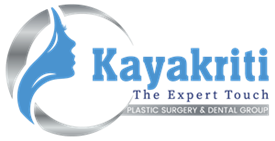



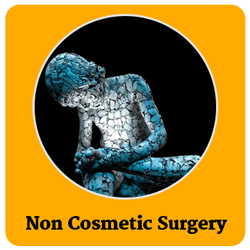























Social Media Presence